Mental health patient-reported experience measures (PREMs)
This section presents data for the mental health patient-reported experience measures (PREMs) indicators supplied by Australia to the OECD HCQO collection. It compares these data with the results reported for other OECD countries, and comments on the comparability of the data provided to the OECD specification.
The OECD published all mental health PREMs indicators in OECD.Stat and a selection of these indicators in Health at a glance 2023. Australia calculated and submitted 6 of the 8 mental health PREMs indicators requested. These indicators are:
- Care providers treating mental health service users with courtesy and respect (admitted patient care)
- Care providers treating mental health service users with courtesy and respect (community-based care)
- Care providers providing easy-to-understand explanations to mental health service users (admitted patient care)
- Care providers providing easy-to-understand explanations to mental health service users (community-based care)
- Care providers involving mental health service users in decisions about care and treatment (admitted patient care)
- Care providers involving mental health service users in decisions about care and treatment (community-based care).
The indicator definitions can be viewed here: mental health patient-reported experience measures (PREMs) definitions.
Overall data comparability and methods
The most recent data provided by Australia for the mental health patient-reported experience measures (PREMs) indicators corresponds to the year 2020–21. These data are recorded as 2021 in the OECD.Stat database. In this report, we present the latest available data for comparison with other OECD countries, and data for the most recent 5 years for Australia to illustrate time trends. These data were extracted from the OECD.Stat database in January 2024, and may not reflect subsequent updates made to the database.
The OECD requested mental health PREMs data for adults aged 16 and over, disaggregated by age and sex. The OECD then calculated age-sex standardised rates (standardised to the equivalent 2015 OECD population) for these indicators based on the supplied data. The indicators are presented on the same basis here.
The data were sourced from Your Experience of Service survey (YES) data supplied under the Your Experience of Service National Best Endeavours Data Set (YES NBEDS). It should be noted that, currently, only three states/territories provide data under this survey, and variations in methods may exist across states/territories participating in the survey.
Care providers treating mental health service users with courtesy and respect (admitted patient care)
This indicator was derived from multiple questions within the YES survey. These questions specifically inquire about individuals' experiences when engaging with mental health services in an admitted patient care setting.
In Australia, 80% of people aged 16 and over reported that care providers treated them with courtesy and respect in 2021, lower than the OECD average of 81% of people aged 16 and over. Only three other OECD countries reported data for this indicator in 2021. Among those, Portugal had the highest proportion with 100% of people 16 years and over who reported that their care providers treated them with courtesy and respect.
In Australia, the percentage was higher for males (83%) than females (81%). This rate has been stable over the past 5 years, ranging from 79% in 2018 to 81% in 2020.
Interactive MHPREMs1 below presents Australia’s 5-year trend for this indicator where data are available.
Figures PREMs 1.1 and PREMs 1.2
The figure presents Australia’s 5-year trend for ‘Care providers treating mental health service users with courtesy and respect (admitted patient care)’ indicator. The rate has stayed stable over time.
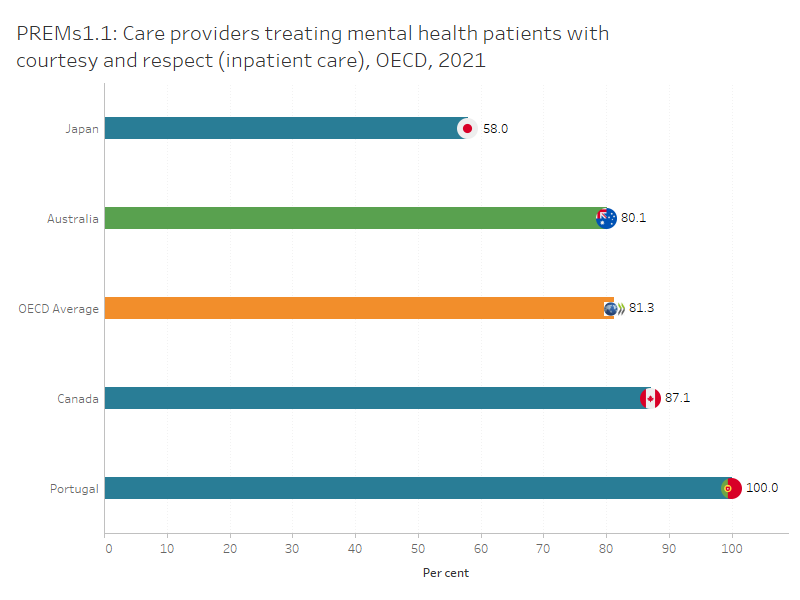
Refer to the Data tables for more information.
Care providers treating mental health service users with courtesy and respect (community-based care)
This indicator was derived from multiple questions within the YES survey. These questions specifically inquire about individuals' experiences when engaging with mental health services in community-based settings.
In Australia, 87.5% of people aged 16 and over reported that care providers treated them with courtesy and respect in community-based mental health care settings in 2021, slightly lower than the OECD average of 88% of people aged 16 and over. Only three other countries reported data for this indicator in 2021. Among those, Canada had the highest proportion of people aged 16 and over who reported that their care providers treated them with courtesy and respect (92.5% of people 16 years and over).
In Australia, this rate has been stable over the past 5 years, ranging from 85% in 2019 to 88% in 2020 and 2021. The percentage was higher for females (90%) than males (88%).
Interactive MHPREMs2 below presents Australia’s 5-year trend for this indicator where data are available.
Figures PREMs 2.1 and PREMS 2.2
The figure presents Australia’s 5-year trend for ‘Care providers treating mental health service users with courtesy and respect (community-based care)’ indicator. The rate has stayed stable over time.
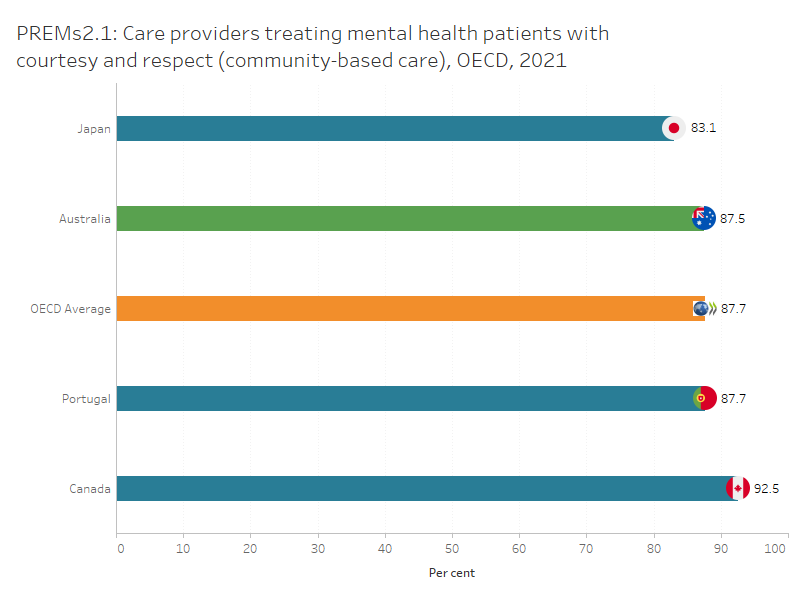
Refer to the Data tables for more information.
Care providers providing easy-to-understand explanations to mental health service users (admitted patient care)
This indicator was derived from multiple questions within the YES survey. These questions specifically inquire about individuals' experiences when engaging with mental health services in an admitted patient care setting.
In Australia, 54% of people aged 16 and over reported that their care providers provided easy-to-understand explanations in 2021, lower than the OECD average of 69% of people aged 16 and over. Only three other countries reported data for this indicator in 2021. Among those, Portugal had the highest proportion of people aged 16 and over reported that the care providers providing easy-to-understand explanations to mental health service users (89% of people 16 years and over).
In Australia, this rate has remained relatively stable over the past 5 years The percentage was higher for males (59%) than females (54.5%).
Interactive MHPREMs3 below presents Australia’s 5-year trend for this indicator where data are available.
Figures PREMs 3.1 and PREMs 3.2
The figure presents Australia’s 5-year trend for ‘Care providers providing easy-to-understand explanations to mental health service users (admitted patient care)’ indicator. The rate has fluctuated over time.
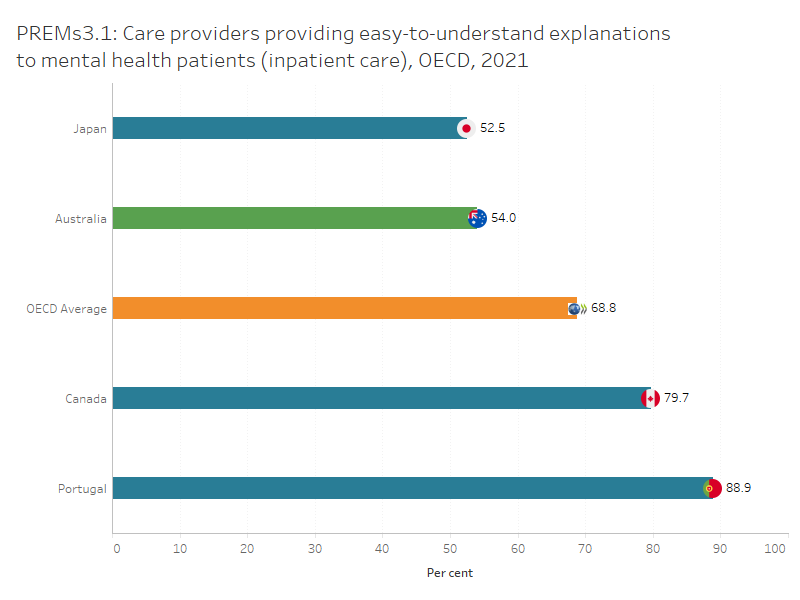
Refer to the Data tables for more information.
Care providers providing easy-to-understand explanations to mental health service users (community-based care)
This indicator was derived from multiple questions within the YES survey. These questions specifically inquire about individuals' experiences when engaging with mental health services in community-based settings.
In Australia, 66% of people aged 16 and over reported that the care providers providing easy-to-understand explanations to mental health service users in 2021, lower than the OECD average of 78%. Only three other countries reported data for this indicator in 2021. Among those, Portugal had the highest proportion of people aged 16 and over reported that the care providers providing easy-to-understand explanations to mental health service users (94% of people 16 years and over).
In Australia, this rate has remained relatively stable over the past 5 years. The percentage was higher for females (68%) than males (67%).
Interactive MHPREMs4 below presents Australia’s 5-year trend for this indicator where data are available.
Figures PREMs 4.1 and PREMs 4.2
The figure presents Australia’s 5-year trend for ‘Care providers providing easy-to-understand explanations to mental health service users (community-based care)’ indicator. The rate has fluctuated over time.
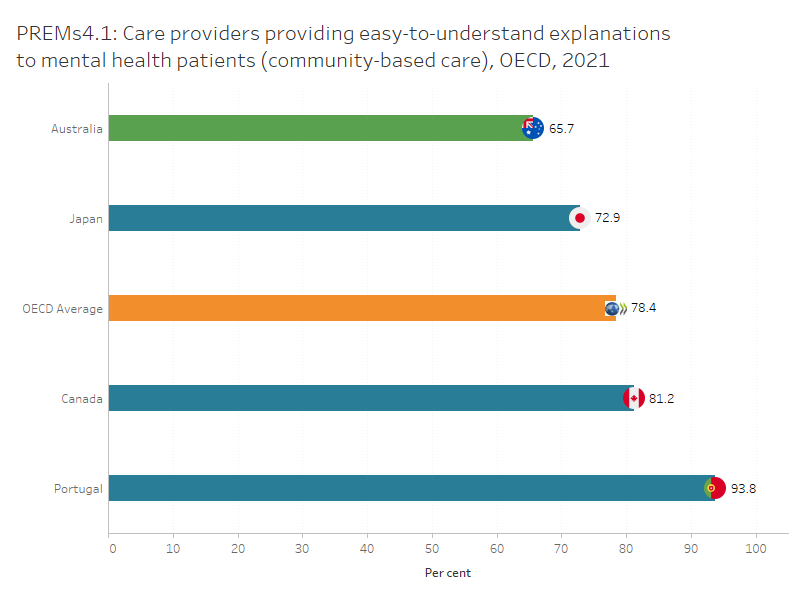
Refer to the Data tables for more information.
Care providers involving mental health service users in decisions about care and treatment (admitted patient care)
This indicator was derived from multiple questions within the YES survey. These questions specifically inquire about individuals' experiences when engaging with mental health services in an admitted patient care setting.
In Australia, 71% of people aged 16 and over reported that care providers involving mental health service users in decisions about care and treatment in 2021, lower than the OECD average of 74.5%. Only three other countries reported data for this indicator in 2021. Among those, Portugal had the highest proportion of people aged 16 and over reported that the care providers involving mental health service users in decisions about care and treatment (100% of people 16 years and over).
In Australia, the percentage was higher for males (75%) than females (72%). This rate has remained relatively stable over the past 5 years.
Interactive MHPREMs5 below presents Australia’s 5-year trend for this indicator where data are available.
Figures PREMs 5.1 and PREMs 5.2
The figure presents Australia’s 5-year trend for ‘Care providers involving mental health service users in decisions about care and treatment (admitted patient care)’ indicator. The rate has fluctuated over time.
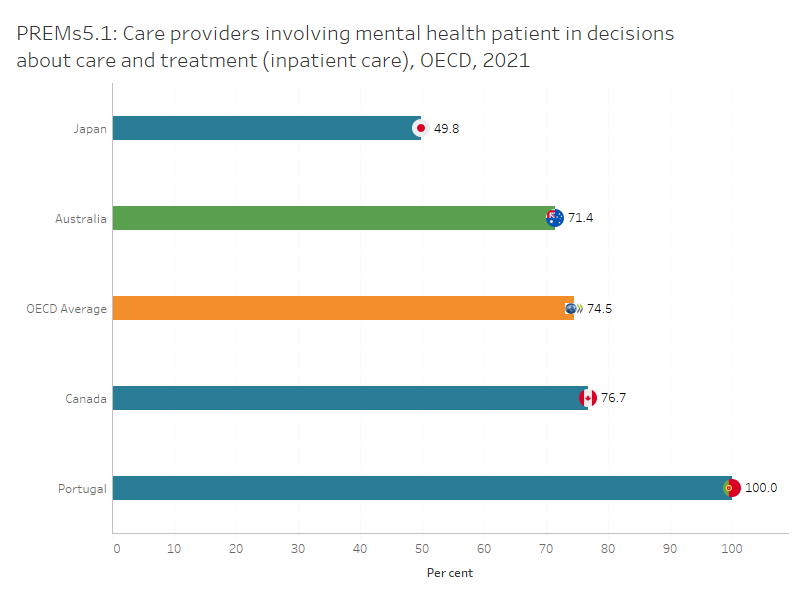
Care providers involving mental health service users in decisions about care and treatment (community-based care)
This indicator was derived from multiple questions within the YES survey. These questions specifically inquire about individuals' experiences when engaging with mental health services in community-based settings.
In Australia, 81.7% of people aged 16 and over reported that care providers involving mental health service users in decisions about care and treatment in 2021, this is similar to the OECD average of 82.2% of people aged 16 and over. Only three other countries reported data for this indicator in 2021. Among those, Portugal had the highest proportion of people aged 16 and over who reported that the care providers involving mental health service users in decisions about care and treatment (93% of people 16 years and over).
In Australia, the percentage was higher for females (84%) than males (82%). This rate has remained relatively stable over the past 5 years.
Interactive MHPREMs6 below presents Australia’s 5-year trend for this indicator where data are available.
Figures PREMs 6.1 and PREMs 6.2
The figure presents Australia’s 5-year trend for ‘Care providers involving mental health service users in decisions about care and treatment (community-based care)’ indicator. The rate has fluctuated over time.
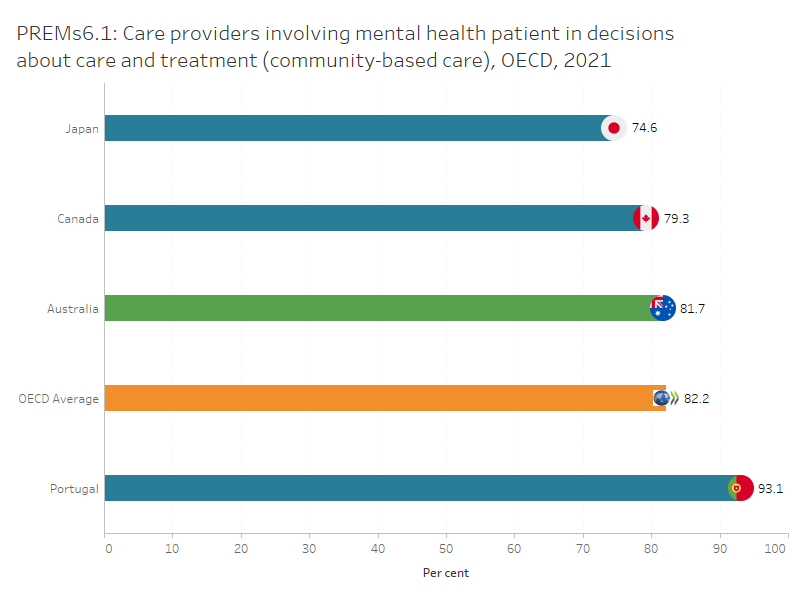
Refer to the Data tables for more information.
References
OECD 2023. Health at a glance 2023: OECD indicators. Paris: OECD.


